RadDataForm Styling
If you followed the getting started section, you now know how to edit an object's properties with RadDataForm for NativeScript. This article will show you how to change the style of each editor, its label or the groups if grouping is enabled.
CSS
The easiest way to change the styles in RadDataForm is to apply css styles. You can use the following type selectors to define the styles for the different elements:
- RadDataForm: Can be used to apply styles the whole DataForm.
- DataFormEditorLabel: Can be used to style the labels of the editors.
- DataFormEditorCore: Can be used to style the different editors - TextField, DatePicker, etc.
-
PropertyEditor: Can be used to style the full editor for a property, that includes the core editor (
DataFormEditorCore) and its header text (DataFormEditorLabel).
Please note that currently the group headers can't be styles with CSS.
Figure 1: RadDataForm with applied css on Android (left) and iOS (right)

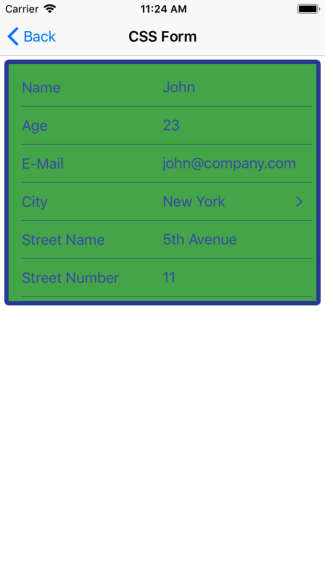
Here's the css that is used for the form in the above pictures:
Example 1: Applying css with the RadDataForm type selector
RadDataForm {
background-color: #4CAF50;
color: #3F51B5;
padding: 5;
margin: 5;
border-color: #303F9F;
border-width: 5;
border-radius: 5;
}
PropertyEditor {
background-color: transparent;
separator-color: #303F9F;
}
The above example uses the RadDataForm and PropertyEditor selectors. Here's how you can use the other available selectors (DataFormEditorCore and DataFormEditorLabel) to match the separate elements of the form and also how to apply a different style to editors while they are focussed:
Example 2: Applying css with the PropertyEditor, DataFormEditorLabel and DataFormEditorCore type selectors
PropertyEditor {
background-color: #00BCD4;
color: #303F9F;
border-color: #303F9F;
border-width: 5;
border-radius: 5;
margin: 10;
padding: 10;
font-size: 14;
}
PropertyEditor:focus {
background-color: #303F9F;
}
DataFormEditorLabel {
color:#212121;
background-color: white;
font-style: italic;
padding: 10;
margin: 10;
border-color: #303F9F;
border-width: 5;
border-radius: 5;
width: 150;
position: left;
}
DataFormEditorCore {
margin: 10;
padding: 10;
background-color: white;
border-color: #303F9F;
border-width: 5;
border-radius: 5;
font-family: 'Times New Roman', Times, serif;
}
PropertyEditor[type='Email'] {
font-weight: bold;
}
EntityProperty[name='name'] DataFormEditorLabel {
width: 0;
visibility: collapsed;
}
Note how you can use EntityProperty with name to match only the editors for a specific property and also you can use PropertyEditor with type to match all editors of a specific type. Here's how the form will look when the above style is applied.
Figure 2: RadDataForm with applied css on Android (left) and iOS (right)
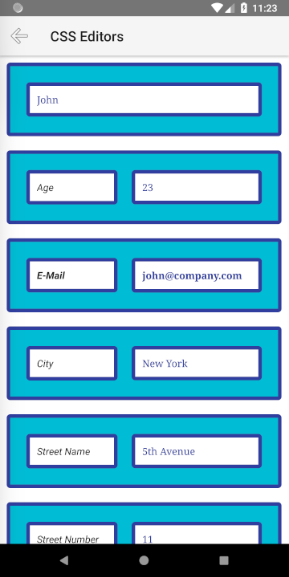
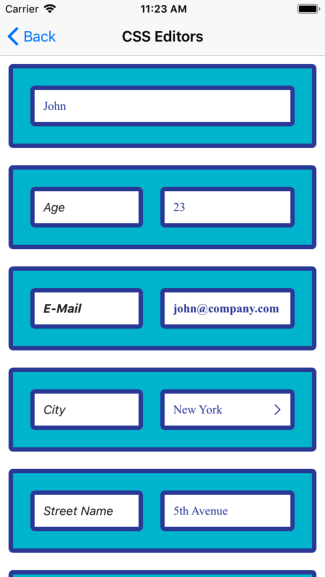
This is the list of supported css properties for the different selectors:
| property | description | RadDataForm | PropertyEditor | DataFormEditorLabel | DataFormEditorCore |
|---|---|---|---|---|---|
color |
Sets the color for the foreground. | yes | yes | yes | yes |
background-color |
Sets the color for the background. | yes | yes | yes | yes |
border-color |
Sets the color for the border. | yes | yes | yes | yes |
font-family |
Sets the font family. | yes | yes | yes | yes |
font-style |
Sets the font style (normal or italic) . | yes | yes | yes | yes |
font-weight |
Sets the font weight. | yes | yes | yes | yes |
font-size |
Sets the font size (dip only). | yes | yes | yes | yes |
margin |
Sets the distance of the view within its parent. | yes | yes | yes | yes |
padding |
Sets the distance between the border and the content. | yes | yes | yes | yes |
border-width |
Sets the width of the border. | yes | yes | yes | yes |
border-radius |
Sets the radius of the border. | yes | yes | yes | yes |
visibility |
Sets the view visibility (visible or collapsed). | yes | no | yes | no |
position |
Sets the position of the label relative to the editor. (left or top) | no | no | yes | no |
width |
Sets the width of the view. | yes | no | only when position is left | no |
height |
Sets the height of the view. | yes | no | no | no |
separator-color |
Sets the color of the line separator of the editor. | no | only on iOS | no | no |
Styling Editors
In order to change the style of an editor, you need to follow these steps:
- Declare the
TKEntityPropertyand set thetkPropertyGroupPropertiesinline directive to it in your HTML. - Between its tags declare an
TKPropertyEditorand set thetkEntityPropertyEditorinline directive to it. - Finally between the
TKPropertyEditortags declare theTKPropertyEditorStyleand set thetkPropertyEditorStyleinline directive to it
Here's what you can update in editor through its style:
-
fillColor: The color that will be used as background of the editor. -
strokeColor: The color of the border of the editor. -
strokeWidth: The width of the border of the editor. -
separatorColor: The color of the line separator of the editor /iOS only/. -
labelTextSize: The size of the text of the editor's label. -
labelFontName: The name of the font that is used for the text of the editor's label. -
labelFontStyle: TheDataFormFontStylefor the text of the editor's label. -
editorHorizontalOffset: Horizontal offset to be applied to the editor. -
editorVerticalOffset: Vertical offset to be applied to the editor. -
labelHorizontalOffset: Horizontal offset to be applied to the editor's label. -
labelVerticalOffset: Vertical offset to be applied to the editor's label. -
labelHidden: Indicates whether this editor will have its label visible or hidden. -
labelPosition: Indicates the position of the label relative to the editor. It must be one of:Left(default on iOS) orTop(default on Android). -
labelWidth: The width of the label. It has effect only if thelabelPositionisLeft.
If you need to make changes to the styles runtime, you can get access the current style of an editor through the TKEntityProperty. Here's an example of how to change the fillColor for the editor of the property name.
Figure 3: RadDataForm with some of the editor's styling properties changed on Android (left) and iOS (right)
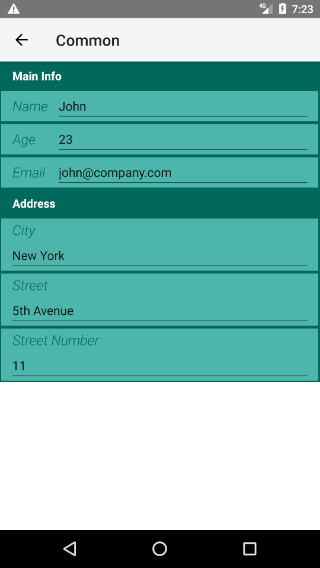

Example 3: Changing the fillColor of an editor
public changeEditorFill() {
const property = this.myRuntimeDataFormComp.dataForm.getPropertyByName("name");
property.editor.propertyEditorStyle.fillColor = new Color("LightBlue");
}
Note that in this example we make the change when RadDataForm is already loaded and its editors are initialized (in this case on a button tap), otherwise the default PropertyEditorStyle may not be initialized and propertyEditorStyle will be undefined.
Styling Group Headers
In order to change the style of the header of a group, you need to create an instance of TKGroupTitleStyle containing the tkPropertyGroupTitleStyle inline directive and declare it between the TKPropertyGroup's tags. Here's what you can update in the header of a group through its style:
-
fillColor: The color that will be used as background of the group header. -
strokeColor: The color of the border of the group header. -
strokeWidth: The width of the border of the group header. -
separatorColor: The color of the line separator of the group header /iOS only/. -
labelTextSize: The size of the text of the group header. -
labelFontName: The name of the font that is used for the text of the group header. -
labelFontStyle: TheDataFormFontStylefor the text of the group header.
If you need to make changes to the styles runtime, you can get access the current style of a group title through the PropertyGroup. Here's an example of how to change the labelTextColor for the group Main Info.
Example 4: Changing the labelTextColor of a group header
public changeGroupLabelTextColor() {
const group = this.myRuntimeDataFormComp.dataForm.getGroupByName("Main Info");
group.titleStyle.labelTextColor = new Color("Blue");
}
Note that in this example we make the change when RadDataForm is already loaded and its groups are initialized (in this case on a button tap), otherwise the default GroupTitleStyle may not be initialized and titleStyle will be undefined.
Example 5: Using some of the abovementioned styling properties in HTML
<TKEntityProperty tkPropertyGroupProperties name="name">
<TKPropertyEditor tkEntityPropertyEditor type="Text">
<TKPropertyEditorStyle tkPropertyEditorStyle strokeColor="#00695c" strokeWidth="2" fillColor="#4db6ac" labelHidden="false"
labelTextSize="18" ios:labelFontName="Times New Roman" android:labelFontName="sans-serif-light" labelFontStyle="Italic"
labelPosition="Left" labelWidth="60" labelTextColor="#00695c"></TKPropertyEditorStyle>
</TKPropertyEditor>
</TKEntityProperty>
Styling Native Components
Figure 3: RadDataForm with editors' colors updated independently on Android (left) and iOS (right)
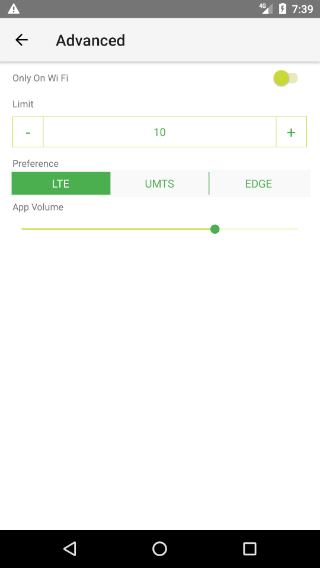
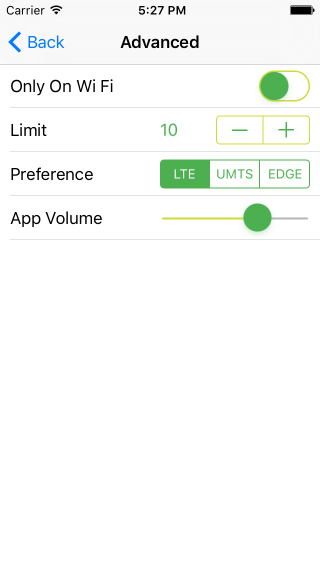
If you need to provide a more customized styling which is not covered by the above properties, you can always fine-tune the native editors for each platform. In order to do this, you can use the editorUpdate event in RadDataForm. First you can use the propertyName from the passed arguments with the events to determine if the currently updated editor is the one you want to customize:
Example 6: Apply styling based on the name of a property
switch (args.propertyName) {
case "appVolume": this.editorSetupSliderAndroid(args.editor); break;
If you want the customization to reflect all editors of specific editor type you can do the check through the EntityProperty that you can get with RadDataForm's getPropertyByName method. Then you can check the editor type:
Example 7: Apply styling based on the type of an editor
const entityProperty: EntityProperty =
(<RadDataForm>args.object).getPropertyByName(args.propertyName);
switch (entityProperty.editor.type) {
case "Slider": this.editorSetupSliderIOS(args.editor); break;
If the currently updating editor is the one we want to customize we can access the native editor through the editor property of the arguments passed with the event. Then depending on the platform, we can access the actual view of the editor with the getEditorView() method on Android and with the editor property on iOS. Here's an example of changing the style of the Slider editor independently on each platform:
Example 8: Change the colors of native Slider editor on each platform
public editorSetupSliderAndroid(editor) {
const coreEditor = <android.widget.SeekBar>editor.getEditorView();
coreEditor.getThumb().setColorFilter(new android.graphics.PorterDuffColorFilter(colorDark.android, android.graphics.PorterDuff.Mode.SRC_IN));
coreEditor.getProgressDrawable().setColorFilter(new android.graphics.PorterDuffColorFilter(colorLight.android, android.graphics.PorterDuff.Mode.SRC_IN));
}
public editorSetupSliderIOS(editor) {
const coreEditor = <UISlider>editor.editor;
coreEditor.tintColor = colorLight.ios;
coreEditor.thumbTintColor = colorDark.ios;
}
In this example we used the properties of the native views that represent the Slider editor: SeekBar on Android and UISlider in iOS.
Here's a list with each of the RadDataForm editors and the corresponding types of the native views used for that editor on each platform:
| Editor | Android Native View | iOS Native View |
|---|---|---|
Text |
EditText | TKTextField |
MultilineText |
EditText | UITextView |
Email |
EditText | TKTextField |
Password |
EditText | TKTextField |
Phone |
EditText | TKTextField |
Number |
EditText | TKTextField |
Decimal |
EditText | TKTextField |
Switch |
SwitchCompat | UISwitch |
Stepper |
RadNumberPicker | UIStepper |
Slider |
SeekBar | UISlider |
Picker |
Spinner | UIPickerView |
SegmentedEditor |
RadioGroup | UISegmentedControl |
List |
ListView | TKLabel |
DatePicker |
EditText | UIDatePicker |
TimePicker |
EditText | UIDatePicker |
AutoCompleteInline |
RadAutoCompleteTextView | TKAutoCompleteTextView |
Label |
TextView | UILabel |
Now that you know how to access the core editor view and what its type is you can dive deeper into the capabilities that the access to the native elements provides. For example you can further adjust the location of an editor and its background:
Figure 4: RadDataForm with editors' background updated manually on Android (left) and iOS (right)
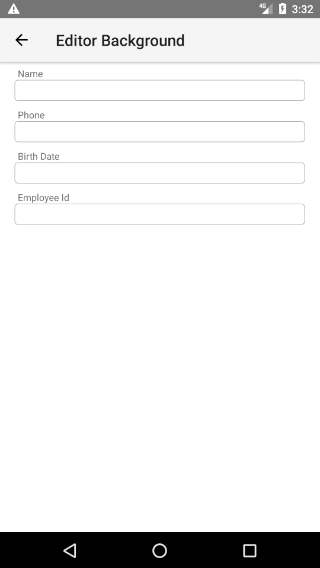
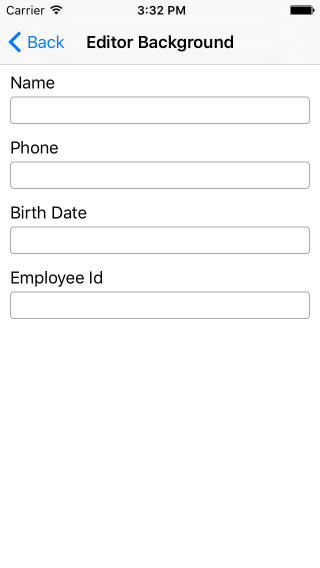
This is achieved again by using the editorUpdate event in RadDataForm and the native editor taken from the parameters of the event arguments:
Example 9: Change the editor background of native editors on each platform
if (ios) {
// Update editor padding
const editorInsets = new UIEdgeInsets({ top: this._editorPaddingVertical, left: this._editorPaddingHorizontal, bottom: this._editorPaddingVertical, right: this._editorPaddingHorizontal });
editor.style.insets = editorInsets;
// Update core editor padding
const coreEditorInsets = new UIEdgeInsets({ top: this._coreEditorPaddingVertical, left: this._coreEditorPaddingHorizontal, bottom: this._coreEditorPaddingVertical, right: this._coreEditorPaddingHorizontal });
if (this._editorHasValueLabel(editorType)) {
editor.showAccessoryImage = false;
}
editor.editorCore.insets = coreEditorInsets;
// Update core editor background
const layer = editor.editorCore.layer;
layer.borderColor = this._strokeColor.ios.CGColor;
layer.borderWidth = this._strokeWidth;
layer.cornerRadius = this._cornerRadius;
} else {
// Update editor padding
const editorOffsetH = layout.toDevicePixels(this._coreEditorPaddingHorizontal);
const editorOffsetV = layout.toDevicePixels(this._coreEditorPaddingVertical);
editor.rootLayout().setPadding(editorOffsetH, editorOffsetV, editorOffsetH, editorOffsetV);
// Update core editor padding
const coreEditorView = editor.getEditorView();
const textOffsetH = layout.toDevicePixels(this._coreEditorPaddingHorizontal);
const textOffsetV = layout.toDevicePixels(this._coreEditorPaddingVertical);
coreEditorView.setPadding(textOffsetH, textOffsetV, textOffsetH, textOffsetV);
// Update core editor background
const drawable = new android.graphics.drawable.GradientDrawable();
drawable.setCornerRadius(layout.toDevicePixels(this._cornerRadius));
drawable.setStroke(layout.toDevicePixels(this._strokeWidth), this._strokeColor.android);
drawable.setColor(this._fillColor.android);
coreEditorView.setBackgroundDrawable(drawable);
}
References
Want to see these scenarios in action? Check our SDK examples for Angular repo on GitHub. You will find these and many other practical examples with NativeScript UI.
- Styling Common Example
- Styling Advanced Example
- Platform Adjustments Example
- Editor Background Example
Related articles you might find useful: